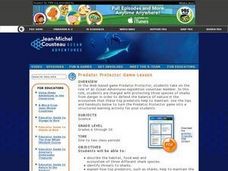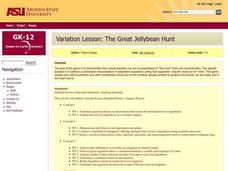Curated OER
Measurement: When Degrees Matter
Eighth graders record the temperature change of the beakers. In this general science lesson, 8th graders create their own data table for recording observations. They discuss experimental results and cite real life applications.
Curated OER
Pulsar Stars And Black Holes
Learners explore the discovery of pulsar stars, and the characteristics of pulsar stars. Theories and ideas behind black holes are discussed. The issues of women's historical role in science are also touched on.
Curated OER
The Lepidoptera Project
Students are introduced to Scientific Inquiry and discover how to design an experiment that answers critical questions using butterflies as the topic. They design experiments that compare the number of species of butterflies in a vacant,...
Curated OER
The Effects of Ultra-Violet Light on Yeast
Students work in small groups collecting and analyzing data as they learn how to best grow yeast. This lesson allows students to conduct several student-created experiments as they continually generate questions and hypotheses. ...
Curated OER
Penguin Paradise
Students read about penguins and communicate their information in a one paragraph summary. In this penguin writing lesson, students review sentence construction. Students complete a KWL about penguins and read the book Penguins Through...
Curated OER
Up, Up and Away
Third graders are presented with the problem of: Do all liquids evaporate at the same rate? The lesson contains adequate background information for the teacher. They participate in a lab experiment in order to test the scientific...
Curated OER
An Introduction to Brine Shrimp
Second graders engage in a lesson that seeks to discover information about Brine Shrimp. They conduct research using a variety of print and electronic resources. Students study the type of environment the shrimp need and read about the...
Curated OER
Hatching Brine shrimp
Second graders investigate the life cycle using brine shrimp as an example. They conduct observations by watching the shrimp hatch out of cysts. Students design simple experiment to structure an observation. The experiment is approved...
Curated OER
Migration Isn't Just For The Birds
Fourth graders explore the concepts of conservation using a reading story that describes a flock of geese. The ecosystems are also described in the lesson and the effects of pollution.
Curated OER
A River Ran Wild
Students describe and illustrate pollution and how to clean up pollution. They display their solutions by creating posters, signs, bumper stickers, slogans, T-shirt designs, commercials and poetry. This instructional activity ties in...
Curated OER
Who's the Father?
Students analyze gels to determine parentage in this lesson about scientific evidence, investigation, and DNA concepts. The lesson includes a pre-activity worksheet, a final individual assessment, and student handouts for in-class...
Curated OER
Energy Balance: The Ins and Outs
Students review data from a 24-hour dietary recall to gain a practical understanding of information regarding energy intake and macronutrients.
Curated OER
Tornadoes
Middle schoolers examine the characteristics of a tornado. They practice using new vocabulary and participate in a question and answer session. They use the internet to gather more specific information.
Curated OER
The Watershed Quest
Students examine their connection to local watersheds. They describe the water cycle and list species living in their local watershed. They also draw a map of their community.
Curated OER
Biology: New Trials & Findings
Students use background knowledge to summarize articles about skin cancer research and present them to the class and place their studies along a clinical study timeline. They are introduced to clincal trails and to various aspects of...
Curated OER
FROG
Studdents are able to identify the metamorphosis of a frog from tadpole to frog. They are able to communicate through writing what they learned about frogs. Students are able to compare what they included in the KWL chart.
Curated OER
Predator Protector Game
Students take on the role of an Ocean Adventures expedition volunteer member and are charged with protecting three species of sharks from danger in order to defend the balance of nature in the ecosystem. They play an online game which...
Curated OER
Biology: Sun, Skin and Cancer
Students identify basic components of skin on a cross sectional diagram. They provide a basic description of cancer in terms of cell biology. Students explore the ABCD of skin cancer/mole evaluation and perform their own evaluation of...
Curated OER
The Great Jellybean Hunt
Students explore natural selection and its influence on the populations to fine tune traits and characteristics. The acquisition of traits developed out of need is examined through a game played in class.
Benjamin Franklin Tercentenary
Guess What Benjamin Franklin Did!
Young scholars research Ben Franklin's inventions. In this invention lesson, students see the relationship between a need and an invention. Young scholars will engage in a class discussion, read a handout, and play a match the invention...
Curated OER
Saving Sponge Bob Square Pants
Students apply the use of technology to real life scenarios. In this technology lesson, students discuss and identify a method to move sponge bob from one location to the next, without touching the floor. They share the same landmark and...
Curated OER
Insect Monitoring
Students practice the scientific method in the classroom, either in preparation or as a substitution for real-world field experience. They examine a simulated biodiversity research situation, using a "mini-plot" or
sampling square...
Curated OER
Thanks Be To You
Students research U.S. history by completing a worksheet activity in class. In this historical figure lesson, students identify the contributions and risks taken by the former African-American leader Martin Luther King Jr. Students read...
Curated OER
Teaching about the Effect of Photosynthesis and
Students demonstrate the effects of photosynthesis and respiration. They decide which variables to analyze in a microcosm study. They produce a written paper, oral presentation, poster, or multi-media presentation

























